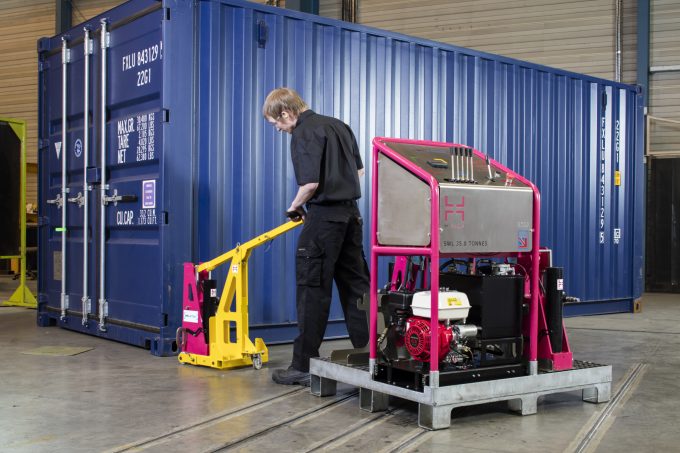VGM container weight mis-declaration 'rampant at most ports', say forwarders
Container carriers are dealing with widespread weight mis-declarations by shippers, refuelling long-standing ship safety hazard ...
GM: RAISING THE ROOF GGM: IN FULL THROTTLE GZIM: MAERSK BOOST KNIN: READ-ACROSSMAERSK: NOT ENOUGHMAERSK: GUIDANCE UPGRADEZIM: ROLLERCOASTERCAT: HEAVY DUTYMAERSK: CATCHING UP PG: DESTOCKING PATTERNSPG: HEALTH CHECKWTC: THE FALLGXO: DEFENSIVE FWRD: RALLYING ON TAKEOVER TALKODFL: STEADY YIELDVW: NEW MODEL NEEDEDWTC: TAKING PROFIT
GM: RAISING THE ROOF GGM: IN FULL THROTTLE GZIM: MAERSK BOOST KNIN: READ-ACROSSMAERSK: NOT ENOUGHMAERSK: GUIDANCE UPGRADEZIM: ROLLERCOASTERCAT: HEAVY DUTYMAERSK: CATCHING UP PG: DESTOCKING PATTERNSPG: HEALTH CHECKWTC: THE FALLGXO: DEFENSIVE FWRD: RALLYING ON TAKEOVER TALKODFL: STEADY YIELDVW: NEW MODEL NEEDEDWTC: TAKING PROFIT

As the deadline for shippers to deliver the verified gross mass of their export containers to their shipping line draws ever closer, two portable weighing solutions have been introduced by technology firms.
In some jurisdictions, ports have stepped into what is rapidly becoming a yawning breach of weighing capacity and informed local exporters that they will offer container weighing solutions either at terminal gates or within terminal grounds.
However, other jurisdictions, such as New Zealand, say their ports will not accept a container arriving at the gates without a VGM.
“All export bound containers from road, rail or coastal transhipment vessel must have the VGM information before they are received onto a port container terminal. No VGM, no entry,” said a joint letter from New Zealand’s port companies to exporters a few weeks ago.
As result, New Zealand company Bison was one of the first to develop a mobile container weighing system that used four load cells inserted under the corners of a landed container lifted by jacks to determine the box’s weight.
It has since extended its range and launched the C-Legs weighing system. This will allow shippers to weigh a container when it is loaded onto a truck chassis, by using four trolley-mounted steel legs that take the weight of the container when it is raised by the chassis’ pneumatic system. A video of the system can be seen here.
Container weighing is now becoming an increasingly well-populated marketplace – UK firm Hy-Dynamix introduced its Hy-Weight system last week.
The system can weigh containers of up to 35 tonnes and uses four corner hydraulic elevation jacks, raising the container and displaying the weight in increments of 50kg via a digital read-out.
Hy-Weigh is self-contained on a specially designed pallet, and its controls allow for individual corner raising and lowering.
Hy-Dynamix managing director Graeme Parkins said: “We have designed a product which is simple, easy to use, and reliable, with no complex software or electronics.
“Hy-Weigh removes the need for dedicated container craneage weighing systems and weighbridges; it is easily deployed and moved around a facility, and we are very proud to say it is manufactured in the UK,” he added.
Several simple solutions to the forthcoming VGM requirement have been developed, mitigating many shippers’ complaints that the technology would be prohibitively expensive.
However, at a roundtable discussion at last week’s Multimodal event in Birmingham, suppliers of weighing equipment warned shippers that orders were piling up globally and there was likely to be a considerable fulfilment backlog when the new regulations come into force on 1 July.
Comment on this article
Mike
May 18, 2016 at 5:59 pmSo…….. this weights a containers that’s on the floor. What about when its on the chassis? — how many exporters keep containers on the floor without chassis?
Just use the Tare weight of the container– and a scale to weight the cargo your loading on the container. Weight of cargo + Tare weight of container = VGM
Gavin van Marle
May 19, 2016 at 9:10 amHello Mike,
The new Bison Jacks solution is designed to weigh the container when it’s on the chassis for precisely the reason you raise. I wouldn’t normally do someone else’s marketing for them, but given the increasing urgency of the situation, here’s a video of how it works: http://www.bison-jacks.com/c-legs/
You are perfectly right though – Method 2 is equally simple
Thanks,
Gavin
Mike
May 19, 2016 at 3:38 pmGavin,
Thanks for that clarification. The picture in the article made it seem that you had to do it from the floor.
The link provides a much better picture of what this is capable of doing.
Gavin van Marle
May 20, 2016 at 9:57 amTo be honest, the fault probably lies with me and my limited powers of explication!